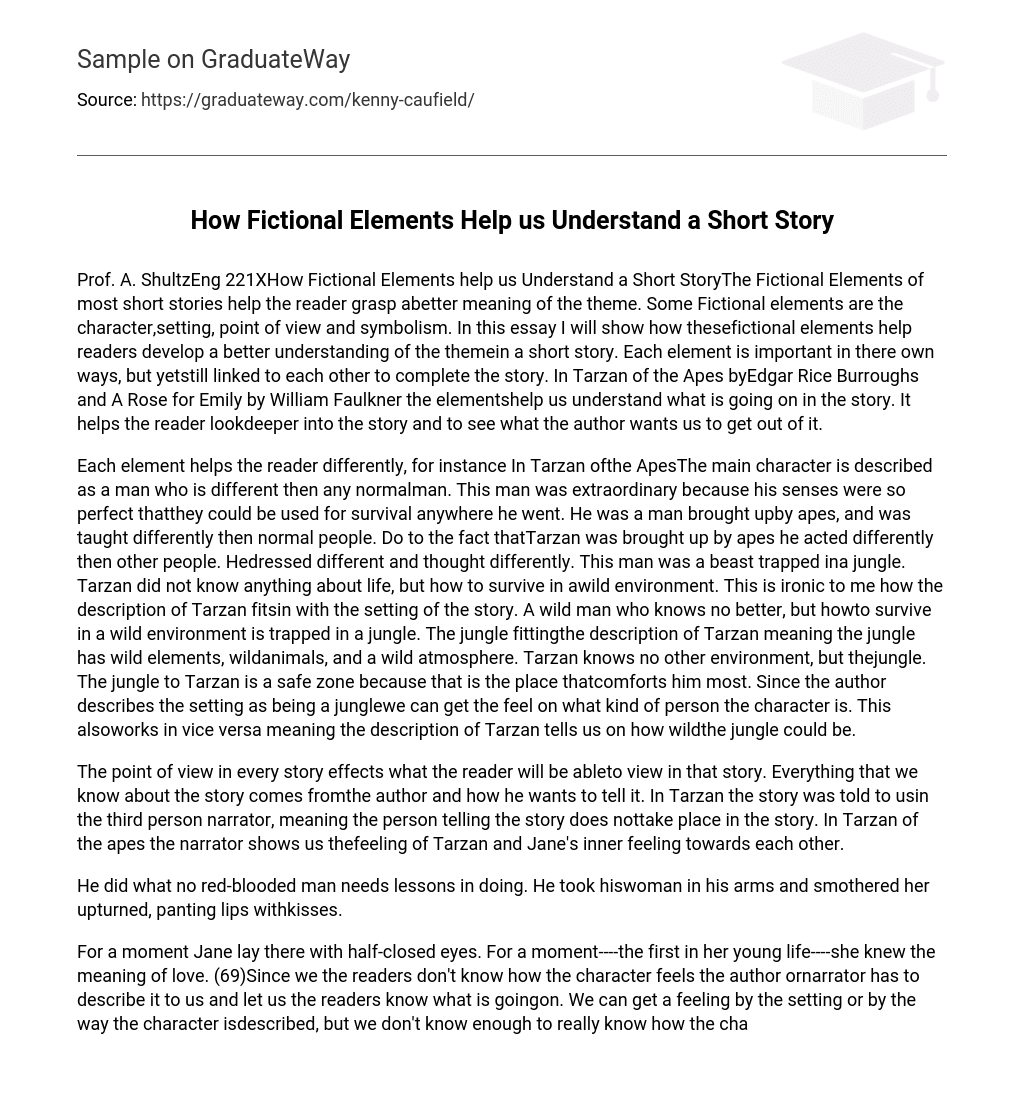The purpose of this essay is to show how the fictional elements in short stories – characters, setting, point of view, and symbolism – work together to help readers better understand the theme. These elements are crucial in aiding readers’ comprehension of the theme.
The individual significance of elements in both Tarzan of the Apes by Edgar Rice Burroughs and A Rose for Emily by William Faulkner is interconnected, forming a cohesive narrative. These elements aid our understanding of events and themes within the stories, enabling readers to delve deeper into the narratives and discern the authors’ intended message.
In the story Tarzan of the Apes, each element contributes in a unique way. For instance, the main character is depicted as a man unlike any other. He possesses extraordinary senses that enable him to adapt and survive in any environment. Tarzan, having been raised by apes, had a distinct upbringing that differed from that of ordinary individuals. Consequently, he acted and thought differently from others. His attire and mindset set him apart as he functioned as a wild creature confined within the jungle. Despite his lack of knowledge about conventional life, Tarzan’s ability to thrive in a wilderness setting is ironic and aligns perfectly with the story’s backdrop.
A man who is unfamiliar with civilized society but knows how to survive in a wild environment is trapped in a jungle. The jungle, which embodies the untamed nature of Tarzan with its wild elements, animals, and atmosphere, is the only home that Tarzan knows. For Tarzan, the jungle provides a sense of safety and comfort. Describing the setting as a jungle allows us to understand the character’s personality. Similarly, Tarzan’s portrayal gives us insight into the wildness of the jungle.
The reader’s perspective in a story affects their perception of the events and information presented. The author has control over how the story is told, shaping what the reader knows. In the case of Tarzan, the story is narrated in the third person, with the narrator not being a participant in the events. This narrative style allows the narrator to convey Tarzan and Jane’s emotions towards each other. Tarzan of the apes showcases their intense passion as Tarzan embraces Jane and showers her upturned, eager lips with passionate kisses.
For a brief moment, Jane lay there with partially closed eyes, experiencing love for the first time in her young life (69). Since we, as readers, do not possess knowledge of the character’s emotions, it is imperative for the author or narrator to convey them to us. This can be achieved through the depiction of the environment or the description of the character, yet still, we lack sufficient insight to truly comprehend their sentiments. The narrator’s storytelling style enables us to empathize completely with the narrative, gaining a vivid understanding of the surroundings, characters, and their emotions.
Symbolism is often difficult to identify in short stories or any story, but it can be a valuable tool in enhancing the narrative. In the case of “A Rose for Emily,” I noticed that the author employed symbolism when Emily’s hair was found on the pillow next to Homer. This suggests that Emily had at some point been lying down next to Homer, leading us to speculate that she may have been responsible for his death and desired to keep him with her forever.
The author conveyed this information to us through symbols instead of writing it down. Symbolism is helpful for understanding characters and settings. It allows for better description without explicitly stating it. Then, we noticed an indentation of a head on the second pillow. One of us lifted something from it and, leaning forward, we saw a faint and invisible dust that was dry and acrid in our nostrils. There, we found a long strand of iron-gray hair.
Within the book, this passage prompts inquiries about Homer’s fate and implies that Emily had once reclined in slumber there. Unraveling symbolism in a tale can prove to be arduous for me. Occasionally, I must peruse the narrative repetitively to apprehend the essence behind its symbolic representations. In this specific story, numerous readings and a class discourse were necessary for me to genuinely comprehend the importance of the solitary hair.
Throughout the essay, there is evidence demonstrating the interconnectedness of these elements. Every element is shown to be connected to one another and enhances the prominence of a particular element. The use of fiction allows for a more comprehensive understanding and connection between these elements. Fictional elements provide authors with greater flexibility to create captivating and intriguing stories with unexpected plot twists.





